Energy Profile
Step by step video & image solution for Energy Profile by Chemistry experts to help you in doubts & scoring excellent marks in Class 12 exams.
Updated on:21/07/2023Similar Questions
Given the following graph.
(a) Calculate ΔH for the reaction and energy of activation for the forward and backward reaction.
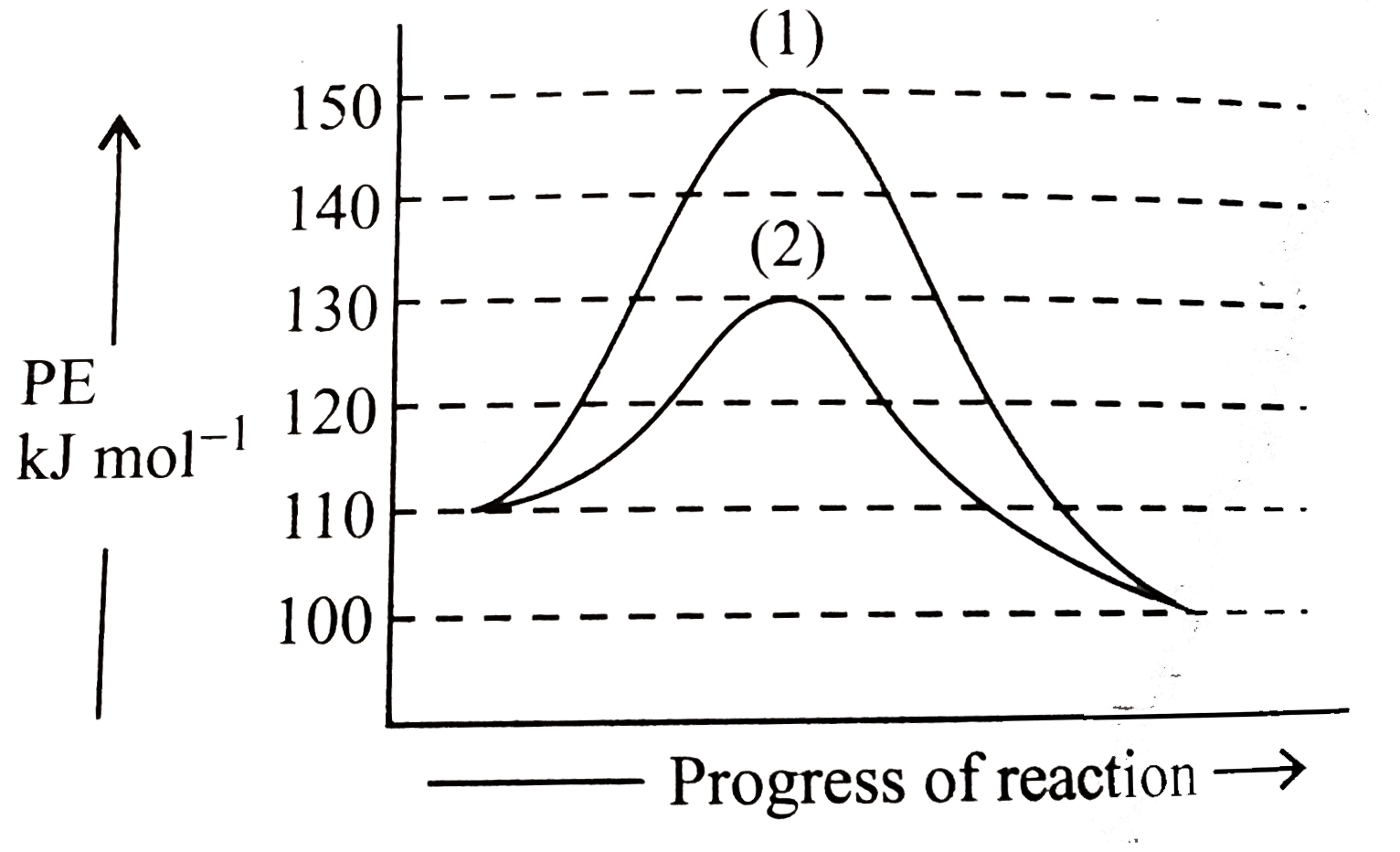
(b) Curve (2) is the energy profile in the presence of a catalyst. What is the energy of activation for the two reaction in the presence of a catalyst?
( c) Will the catalyst change the extent of the reaction?
View Solutionconsider a reaction that occurs by the following mechanism
A+BC→AC+B
AC+D→A+CD
the potential energy profile for the reaction is shown:
a) Write the equation for the overall reaction.
b) What are the different species present at reactions stagest 1 to 5?
c) What is the rate determinig step?

View Solution
Knowledge Check
Substances which alter the velocity of a reaction by mere presence, without undergoing any change in mass and compossition are termed catalyst and the phenomenon is known as catalysis
For the reaction (A→B+C) , the energy profile diagram is given in the figure below.
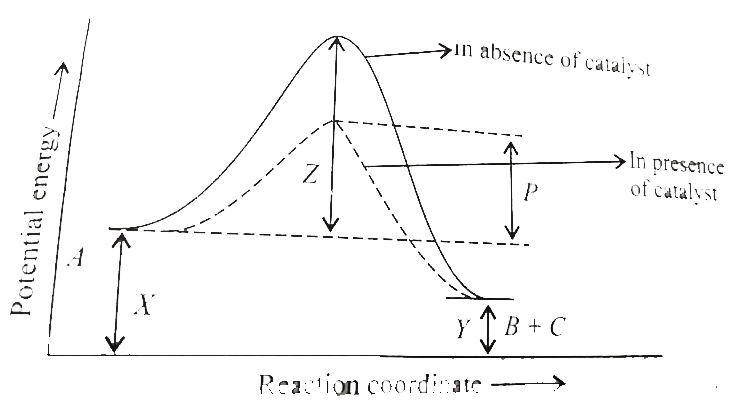
The decrease in ht eenergy of activation in hte presence of catalyst isAZBZ−PCY−ZDZ−XThe energy profile diagrams are very important tool through which, we predict lot of things, like the amount of activation energy of the catalysed and uncatalysed reaction as well as for the backward reaction and forward reaction. Thershold energy of the catalysed and uncatalysed reaction. The graphs representing the energy profile diagram for catalysed and uncatalysed reactions are given below :
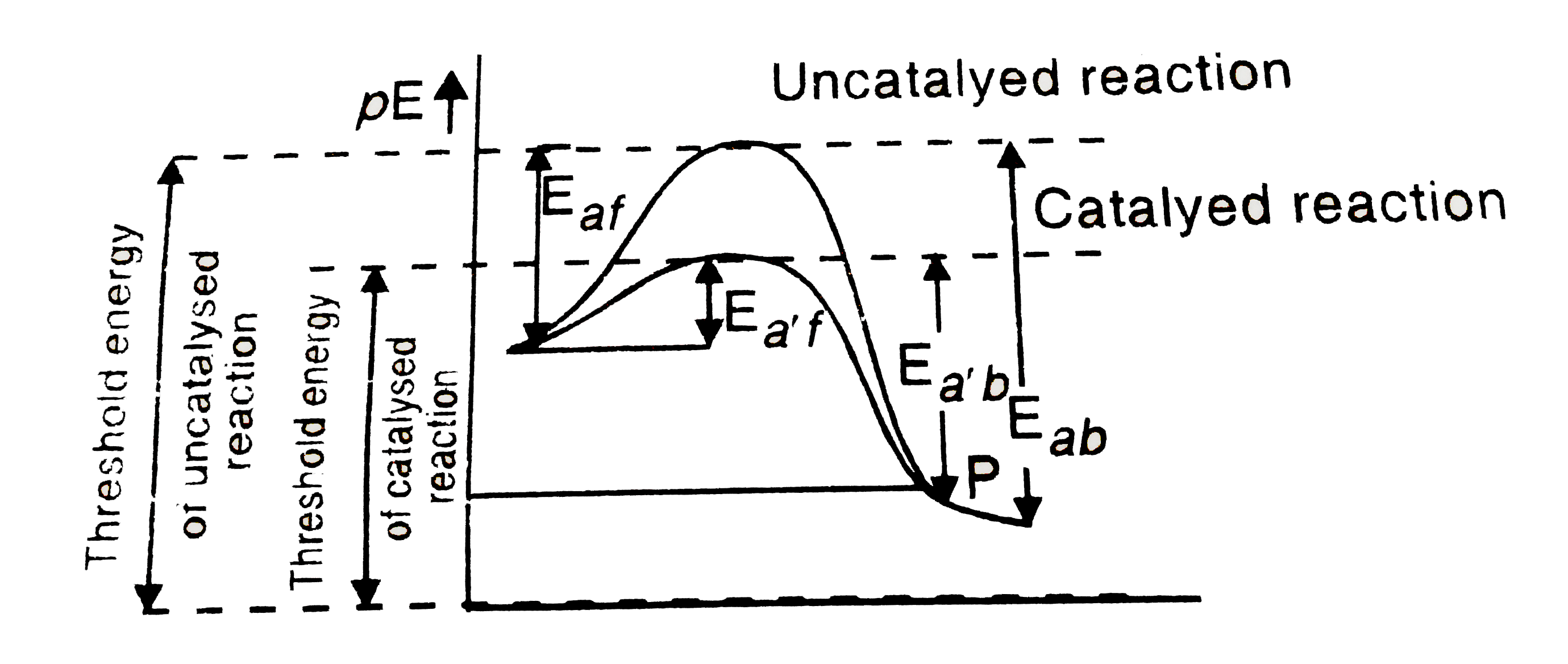
The graph of the lower energy barrier is the energy profile diagram for the catalysed reaction adn of the higher barrier is the energy profile diagram of uncatalysed reaction.
From the graph, it is clear that EafandEab are the activation energy of the respectively. EafandEab are the activation energy of the catalysed forward and backward reaction respectvely
The reaction which occurs by absorption of heat is known as endothermic reaction and by release of heat is known as exothermic reaction
For exothermic reaction, ΔH is negative and for endothermic reaction, ΔH is positive
From Arrhenius equation, we know that k=Ae−Ea/RT where k is rate constant which signifies effective number of collisions. A is known as Arrehnius constant, or maximum rate constant of frequency factor which signifies maximum number of collisions with proper orientation of reacting species per mole per second.
The catalysed reaction occurs at 500 K and the uncatalysed reaction occurs at 800 K in such way so that the rate of catalysed reaction and uncatalysed reaction becomes equal as well as the catalyst lower down the energy barrier by 60 J.
Answer the following questions on the basis of above paragraph
From the given above information, what will be threshold energy for the catalysed reaction. If the normal energy of the reactant is 40 JA170 JB200 JC140 JD180 JThe energy profile diagrams are very important tool through which, we predict lot of things, like the amount of activation energy of the catalysed and uncatalysed reaction as well as for the backward reaction and forward reaction. Thershold energy of the catalysed and uncatalysed reaction. The graphs representing the energy profile diagram for catalysed and uncatalysed reactions are given below :
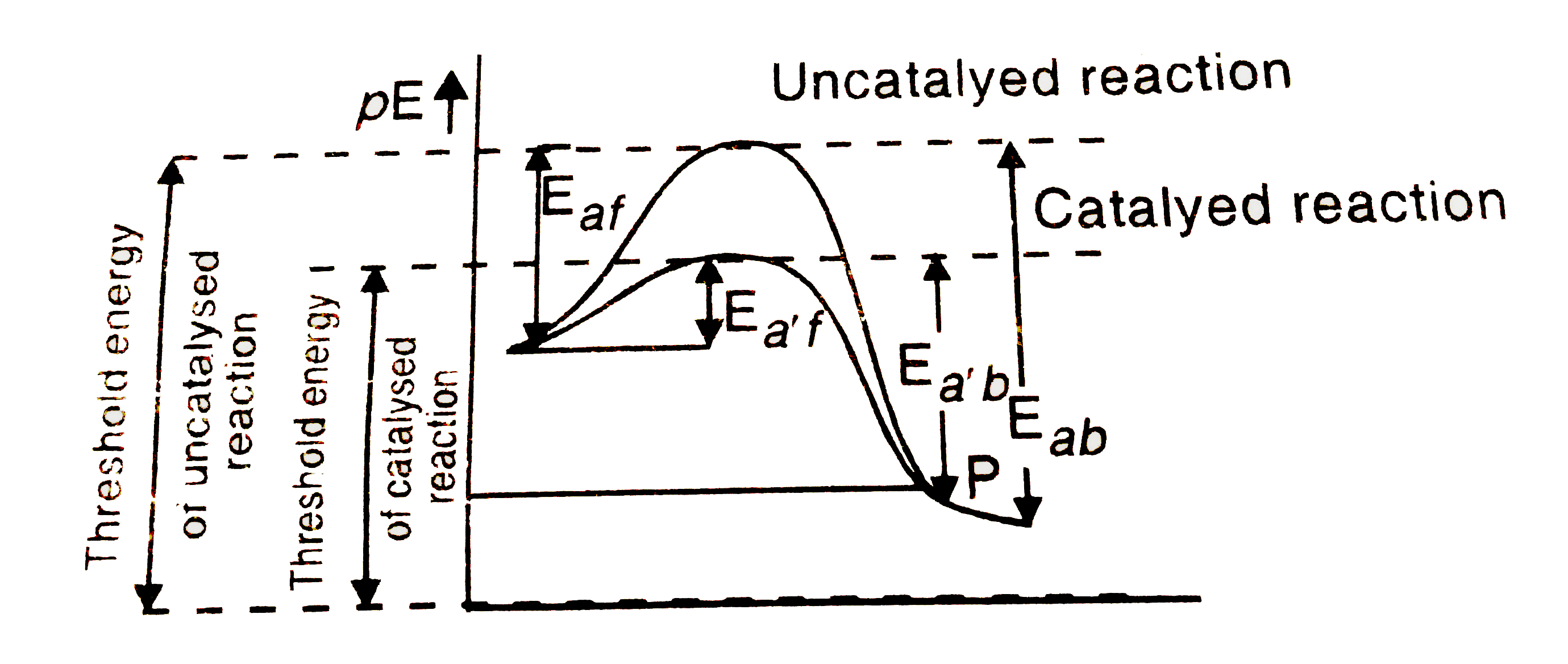
The graph of the lower energy barrier is the energy profile diagram for the catalysed reaction adn of the higher barrier is the energy profile diagram of uncatalysed reaction.
From the graph, it is clear that EafandEab are the activation energy of the respectively. EafandEab are the activation energy of the catalysed forward and backward reaction respectvely
The reaction which occurs by absorption of heat is known as endothermic reaction and by release of heat is known as exothermic reaction
For exothermic reaction, ΔH is negative and for endothermic reaction, ΔH is positive
From Arrhenius equation, we know that k=Ae−Ea/RT where k is rate constant which signifies effective number of collisions. A is known as Arrehnius constant, or maximum rate constant of frequency factor which signifies maximum number of collisions with proper orientation of reacting species per mole per second.
The catalysed reaction occurs at 500 K and the uncatalysed reaction occurs at 800 K in such way so that the rate of catalysed reaction and uncatalysed reaction becomes equal as well as the catalyst lower down the energy barrier by 60 J.
Answer the following questions on the basis of above paragraph
From the above information given inthe compreshension, if the normal energy of the reactant is 50 J and that of the product is 20 J. then what will be the activation energy of the uncatalysed backward reaction ?A170 JB180 JC160 JD190 J
The energy profile diagrams are very important tool through which, we predict lot of things, like the amount of activation energy of the catalysed and uncatalysed reaction as well as for the backward reaction and forward reaction. Thershold energy of the catalysed and uncatalysed reaction. The graphs representing the energy profile diagram for catalysed and uncatalysed reactions are given below :

The graph of the lower energy barrier is the energy profile diagram for the catalysed reaction adn of the higher barrier is the energy profile diagram of uncatalysed reaction.
From the graph, it is clear that EafandEab are the activation energy of the respectively. EafandEab are the activation energy of the catalysed forward and backward reaction respectvely
The reaction which occurs by absorption of heat is known as endothermic reaction and by release of heat is known as exothermic reaction
For exothermic reaction, ΔH is negative and for endothermic reaction, ΔH is positive
From Arrhenius equation, we know that k=Ae−Ea/RT where k is rate constant which signifies effective number of collisions. A is known as Arrehnius constant, or maximum rate constant of frequency factor which signifies maximum number of collisions with proper orientation of reacting species per mole per second.
The catalysed reaction occurs at 500 K and the uncatalysed reaction occurs at 800 K in such way so that the rate of catalysed reaction and uncatalysed reaction becomes equal as well as the catalyst lower down the energy barrier by 60 J.
Answer the following questions on the basis of above paragraph
From the given above information what will be the threshold energy for the uncatalysed reaction, if the normal energy of the reactant is 40 J.
View SolutionThe energy profile diagrams are very important tool through which, we predict lot of things, like the amount of activation energy of the catalysed and uncatalysed reaction as well as for the backward reaction and forward reaction. Thershold energy of the catalysed and uncatalysed reaction. The graphs representing the energy profile diagram for catalysed and uncatalysed reactions are given below :
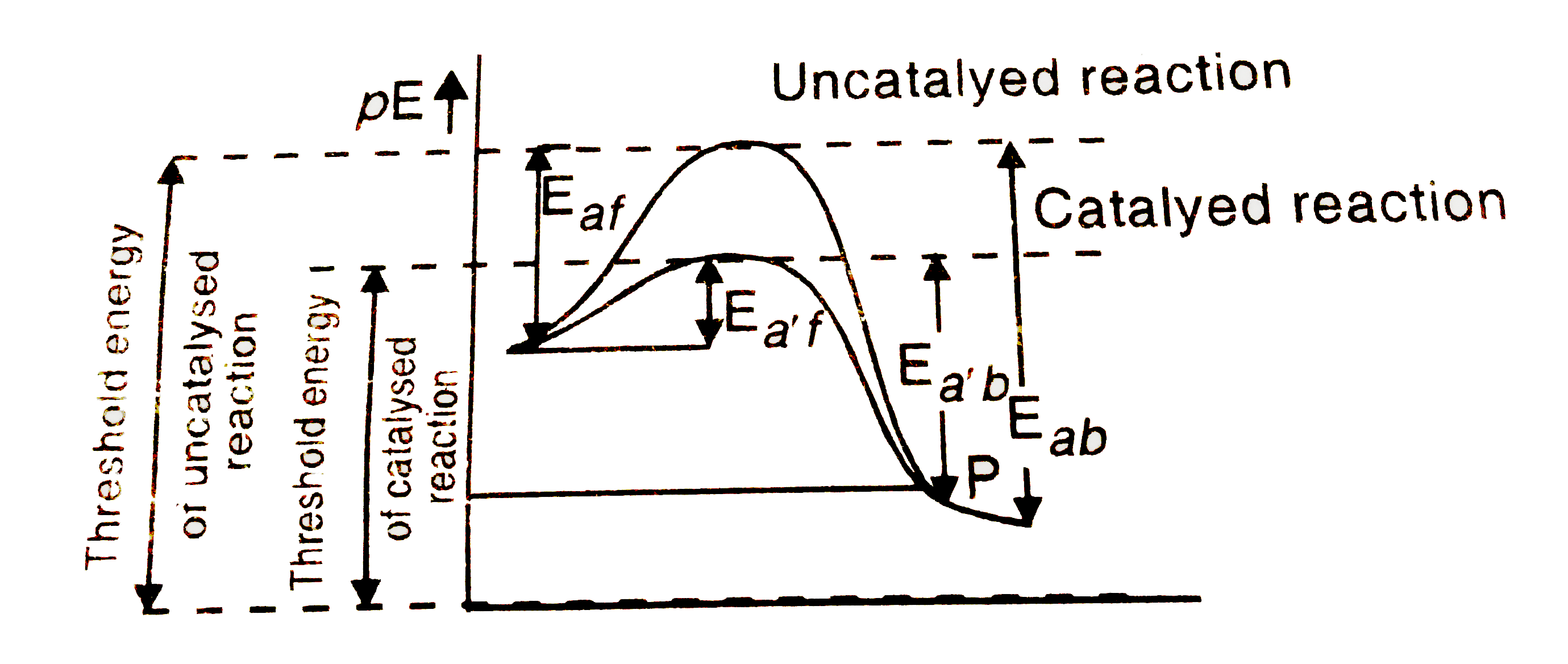
The graph of the lower energy barrier is the energy profile diagram for the catalysed reaction adn of the higher barrier is the energy profile diagram of uncatalysed reaction.
From the graph, it is clear that EafandEab are the activation energy of the respectively. EafandEab are the activation energy of the catalysed forward and backward reaction respectvely
The reaction which occurs by absorption of heat is known as endothermic reaction and by release of heat is known as exothermic reaction
For exothermic reaction, ΔH is negative and for endothermic reaction, ΔH is positive
From Arrhenius equation, we know that k=Ae−Ea/RT where k is rate constant which signifies effective number of collisions. A is known as Arrehnius constant, or maximum rate constant of frequency factor which signifies maximum number of collisions with proper orientation of reacting species per mole per second.
The catalysed reaction occurs at 500 K and the uncatalysed reaction occurs at 800 K in such way so that the rate of catalysed reaction and uncatalysed reaction becomes equal as well as the catalyst lower down the energy barrier by 60 J.
Answer the following questions on the basis of above paragraph
What percentage fraction of the molecule will cross over the energy barrier at 2000 K temperature for 36.848 kJ activation energy ? (Given R = 8 J mol−1K−1)
View SolutionThe energy profile diagrams are very important tool through which, we predict lot of things, like the amount of activation energy of the catalysed and uncatalysed reaction as well as for the backward reaction and forward reaction. Thershold energy of the catalysed and uncatalysed reaction. The graphs representing the energy profile diagram for catalysed and uncatalysed reactions are given below :
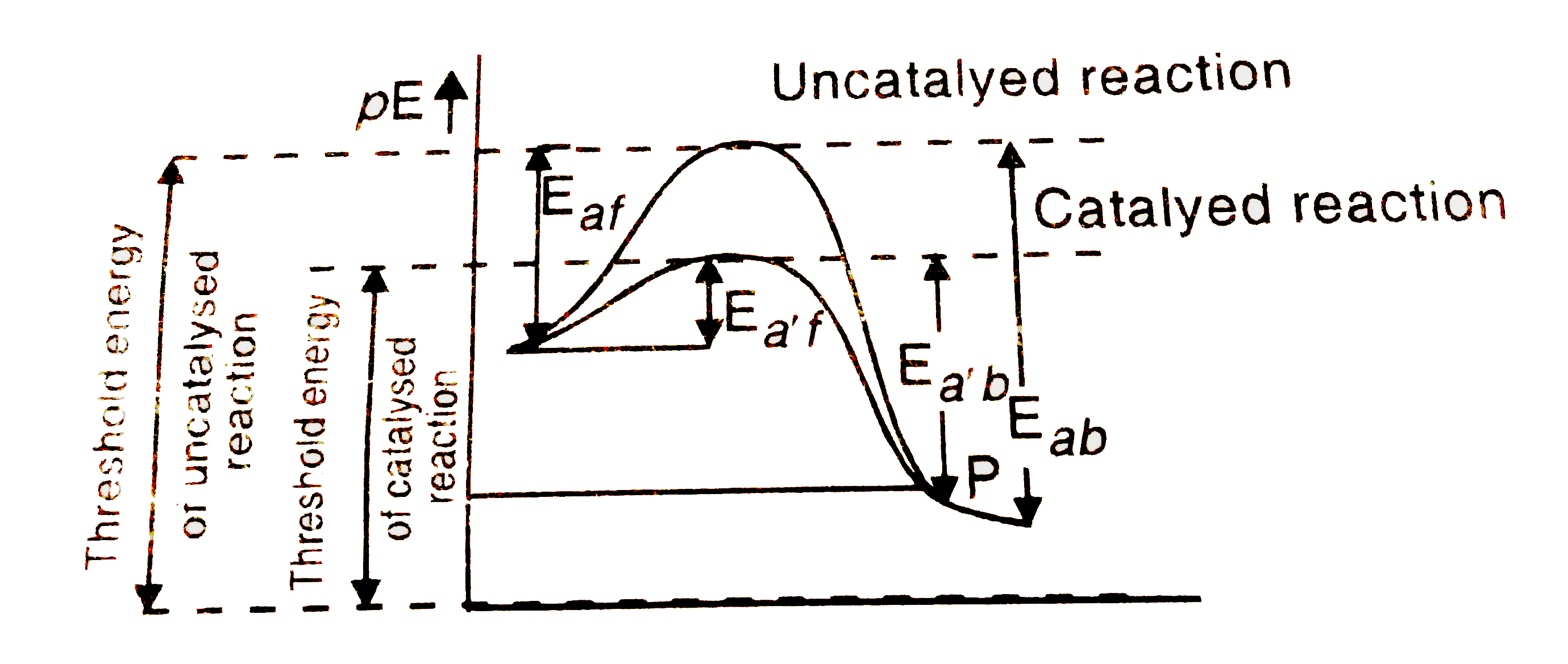
The graph of the lower energy barrier is the energy profile diagram for the catalysed reaction adn of the higher barrier is the energy profile diagram of uncatalysed reaction.
From the graph, it is clear that EafandEab are the activation energy of the respectively. EafandEab are the activation energy of the catalysed forward and backward reaction respectvely
The reaction which occurs by absorption of heat is known as endothermic reaction and by release of heat is known as exothermic reaction
For exothermic reaction, ΔH is negative and for endothermic reaction, ΔH is positive
From Arrhenius equation, we know that k=Ae−Ea/RT where k is rate constant which signifies effective number of collisions. A is known as Arrehnius constant, or maximum rate constant of frequency factor which signifies maximum number of collisions with proper orientation of reacting species per mole per second.
The catalysed reaction occurs at 500 K and the uncatalysed reaction occurs at 800 K in such way so that the rate of catalysed reaction and uncatalysed reaction becomes equal as well as the catalyst lower down the energy barrier by 60 J.
Answer the following questions on the basis of above paragraph
From the above information givenin comprehension as well as from question no. 4, what will be the value of activation energy of the calalysed backward reaction ?
View SolutionThe energy profile diagrams are very important tool through which, we predict lot of things, like the amount of activation energy of the catalysed and uncatalysed reaction as well as for the backward reaction and forward reaction. Thershold energy of the catalysed and uncatalysed reaction. The graphs representing the energy profile diagram for catalysed and uncatalysed reactions are given below :
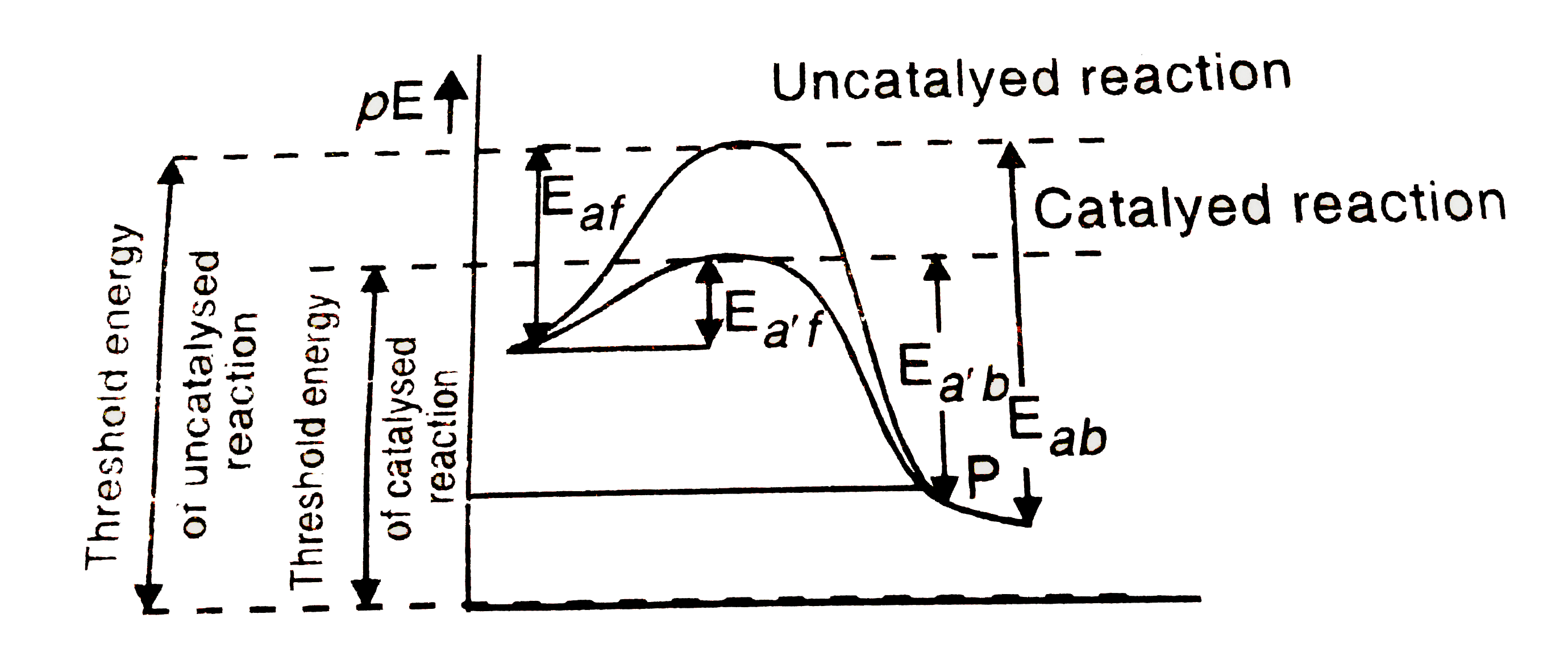
The graph of the lower energy barrier is the energy profile diagram for the catalysed reaction adn of the higher barrier is the energy profile diagram of uncatalysed reaction.
From the graph, it is clear that EafandEab are the activation energy of the respectively. EafandEab are the activation energy of the catalysed forward and backward reaction respectvely
The reaction which occurs by absorption of heat is known as endothermic reaction and by release of heat is known as exothermic reaction
For exothermic reaction, ΔH is negative and for endothermic reaction, ΔH is positive
From Arrhenius equation, we know that k=Ae−Ea/RT where k is rate constant which signifies effective number of collisions. A is known as Arrehnius constant, or maximum rate constant of frequency factor which signifies maximum number of collisions with proper orientation of reacting species per mole per second.
The catalysed reaction occurs at 500 K and the uncatalysed reaction occurs at 800 K in such way so that the rate of catalysed reaction and uncatalysed reaction becomes equal as well as the catalyst lower down the energy barrier by 60 J.
Answer the following questions on the basis of above paragraph
On the basis of question no. 4, what will be the value of threshold energy of the uncatalysed reaction ?
View SolutionThe energy profile diagrams are very important tool through which, we predict lot of things, like the amount of activation energy of the catalysed and uncatalysed reaction as well as for the backward reaction and forward reaction. Thershold energy of the catalysed and uncatalysed reaction. The graphs representing the energy profile diagram for catalysed and uncatalysed reactions are given below :
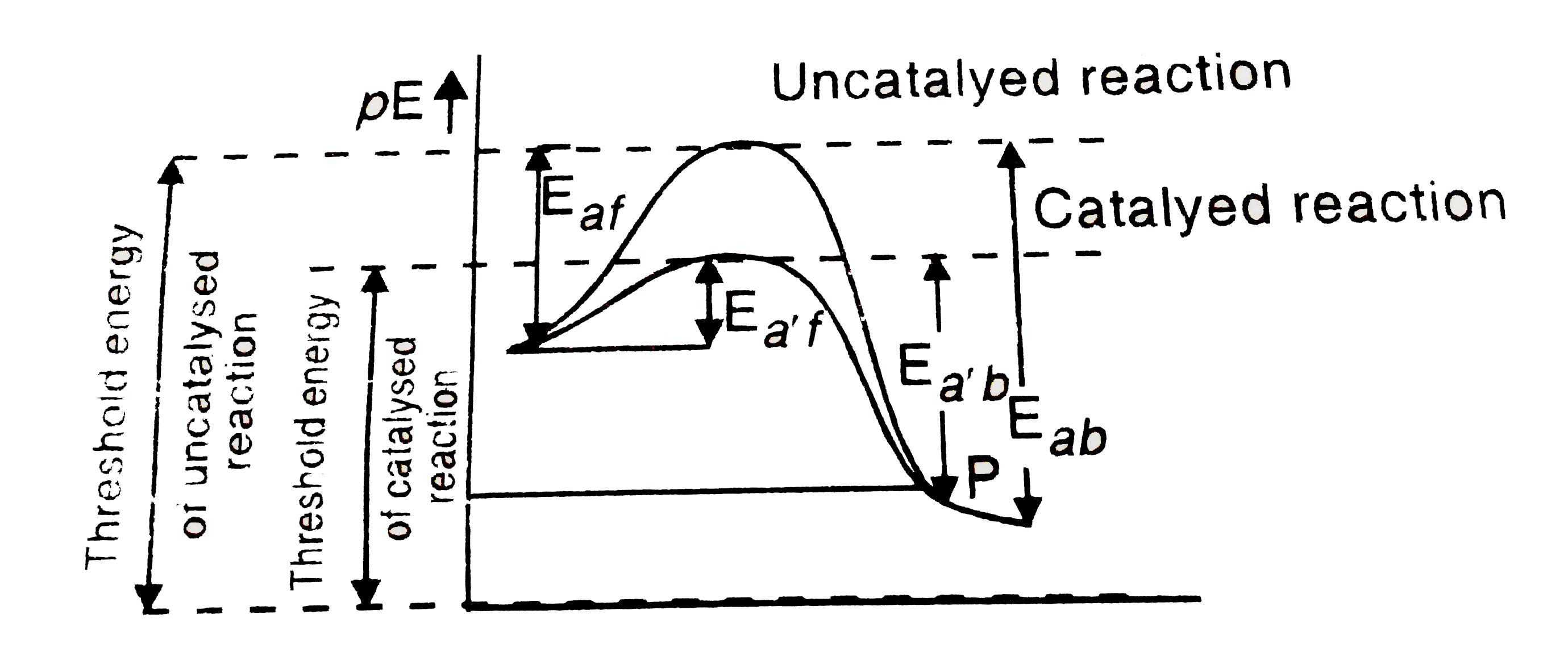
The graph of the lower energy barrier is the energy profile diagram for the catalysed reaction adn of the higher barrier is the energy profile diagram of uncatalysed reaction.
From the graph, it is clear that EafandEab are the activation energy of the respectively. EafandEab are the activation energy of the catalysed forward and backward reaction respectvely
The reaction which occurs by absorption of heat is known as endothermic reaction and by release of heat is known as exothermic reaction
For exothermic reaction, ΔH is negative and for endothermic reaction, ΔH is positive
From Arrhenius equation, we know that k=Ae−Ea/RT where k is rate constant which signifies effective number of collisions. A is known as Arrehnius constant, or maximum rate constant of frequency factor which signifies maximum number of collisions with proper orientation of reacting species per mole per second.
The catalysed reaction occurs at 500 K and the uncatalysed reaction occurs at 800 K in such way so that the rate of catalysed reaction and uncatalysed reaction becomes equal as well as the catalyst lower down the energy barrier by 60 J.
Answer the following questions on the basis of above paragraph
What will be the value of activation energy with respect to the uncatalysed reaction ?
View Solution
